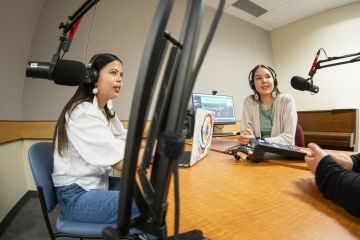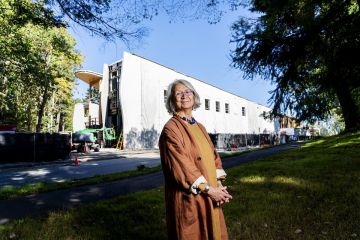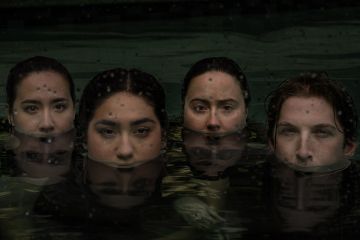Truth and reconciliation leader to advance decolonization work at UVic
- Lisa Abram
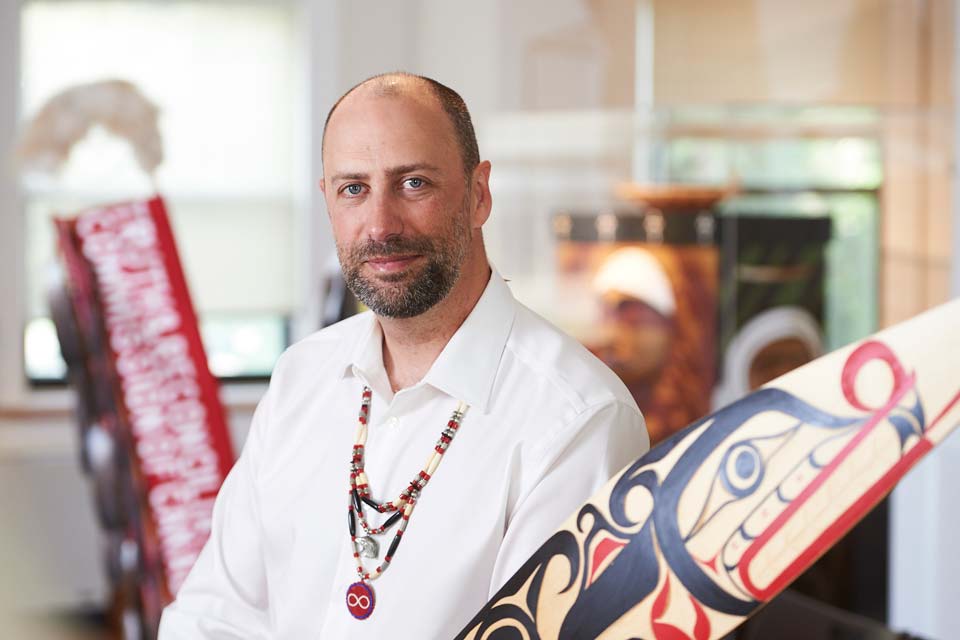
In March 2019, Ry Moran—then the director of the Winnipeg-based National Centre for Truth and Reconciliation (NCTR)—challenged a UVic audience to consider the problem that critical Indigenous knowledge is being lost at an unprecedented rate. With the recent announcement of Moran’s appointment in the newly created position of UVic Associate University Librarian–Reconciliation, UVic Libraries will be looking to partner with Indigenous communities and work to directly address the need to help preserve and sustain Indigenous knowledge, as well as introduce Indigenous approaches to knowledge into the daily work of the Libraries.
Explaining that “reconciliation is driven by a process of listening,” Moran urged the attendees at the 2019 University Librarian’s lecture series to ponder the creation of new thoughtful spaces in academic institutions; to ensure that Indigenous written and oral history is accessible to all; and for a community of active listeners to be nurtured. “I think archives, in so many ways, are a huge collection of voices that are waiting to be heard. Part of animating that is recognizing that they are alive, and that they need to be cared for, and they need to be brought out, and they can’t just sit and collect dust,” says Moran.
The power of social memory
Moran has been the director of the NCTR since its inception in 2013, following three years serving as Director of Statement Gathering and the National Research Centre at the Truth and Reconciliation Commission of Canada (TRC).
With the arrival of Moran at UVic, a stronger connection will be made with internal and external stakeholders in deepening Truth and Reconciliation efforts across the university. Moran’s role will allow him to support cross-campus efforts and work in the archives, and to provide advice and guidance on processes of truth and reconciliation in teaching and research.
“We’ve seen the power that social memory institutions have in this journey. The fact that the NCTR and the TRC focused so heavily on collecting and amassing authoritative information on what has happened, and harnessing the power of that information to better educate and inform Canadians, really reflects how critical memory and social memory institutions are in this overall process,” says Moran.
Moran’s earlier career focus on digitization and Indigenous language preservation prepared him for his time at the helm of the NCTR, where he led the creation of a permanent home of a national archive for all materials gathered by the TRC of Canada.
On the TRC’s behalf, he helped collect nearly 7,000 video and audio-recorded statements of former residential school survivors and others affected by the residential school system. He was also responsible for gathering millions of records that document the residential school system from more than 20 government departments and nearly 100 church archives.
Moran explains that archives in general are woefully imbalanced, and the access to Indigenous collections and materials has not been easy. Often, that information is not brought together in a way to disseminate important social meanings. With the creation of this new position, Moran wants to reveal new insights to stakeholders, and to have a present and active approach working with students and staff.
Ry Moran’s appointment at UVic is unique and the first such position in Canada. It strengthens the university’s aspirational goal to become a global leader in working closely with Indigenous communities towards reconciliation. And it reminds us of the work still to be done in fulfilling this country’s commitment to respect and reconciliation and, on an ongoing basis, to continually heed the calls to action in the recommendations of the Truth and Reconciliation Commission’s final report.
—UVic President Jamie Cassels
Decolonizing the library
Part of the TRC’s mandate was to focus on the acquisition of digital and physical records, to capture the provenance of each record where possible, and to input extensive metadata with each record. This important work will now serve Moran well, as he provides leadership and guidance for the Libraries’ strategic and operational responses to the UVic Strategic Framework (priority 4: Foster Respect and Reconciliation), and the university’s Indigenous Plan.
Moran will work closely with the Office of Indigenous Academic and Community Engagement (IACE) to support their initiatives, particularly as they relate to the TRC’s calls to action; be involved with the Diana M. Priestly Law Library in support of the Faculty of Law’s joint degree program in Canadian Common Law (JD) and Indigenous Legal Orders (JID); and develop best practices on decolonizing library subject guides.
We have to recognize that Indigenous knowledge comes from many sources—some is written down but much of it can only be accessed through relationship, dialogue and listening. If we’re actually going to start to embrace the concept of decolonizing our archives and libraries, we have to really create space for non-paper-based documentary heritage and start creating spaces for knowledge retention within those library and archive spaces. We have to start changing how we think about where knowledge is kept, what it looks like when it’s kept, and what we need to do in order to preserve it.
—Ry Moran, UVic Associate University Librarian–Reconciliation
One example of the current and ongoing work in the University Libraries in the area of decolonization can be seen with the Faculty of Humanities-led project, Colonial Despatches, a free online database containing the correspondence between British authorities and the governors of Vancouver Island and BC from 1846-71. In collaboration and consultation with the First People's Cultural Council and the Union of BC Indian Chiefs, work is ongoing to decolonize the archive with enhanced and revised search terms.
Recently, library intern Karine St-Onge, developed a digital ethics and reconciliation report that explores ethical approaches based on repatriation and decolonization of materials, and ethical issues related to digital libraries and the curation of digital objects.
In addition, librarian Pia Russell was inspired by findings from the TRC to focus on digitizing BC Historical textbooks. Upon hearing the Honourable Justice Murray Sinclair speak about the TRC in 2016, Russell was moved by his declaration of how decades of exclusionary and biased curriculum within the Canadian school system had impaired how Indigenous and non-Indigenous Canadians relate to one another.
Leading Canada into a new era of understanding
Acting as a connective force between teaching, learning, and advocacy at UVic, Moran wants to inspire positive change, and to allow himself to “become the vehicle” through which learners can aspire to do great things.
“Ry is passionate about his Métis heritage, about Indigenous cultural preservation, the revitalization of Indigenous languages, and the honouring of statements and documents,” says UVic Chancellor Shelagh Rogers. “His greatest passion is for truth. I believe that everything Ry has undertaken in his life has led him to this great opportunity with our university.”
“He fervently believes that reconciliation can be built through the archive. He regards the archive as dynamic—a vehicle to preserve collective memory and to help build a vision for the future. He sees reconciliation as innovation. I believe this position is a brilliant innovation. I know Ry to be a person of integrity, honesty, and humility. He has an idea almost every 10 seconds and ardently envisions the University of Victoria as the institution that will lead Canada into a new era of understanding, of healing, and of furthering truth and reconciliation.”
Like the three paddles carved by artist Carey Newman—symbols of the ceremonial bond created by the NCTR, UVic and the work of Truth and Reconciliation—that were presented at the 2019 National Building Reconciliation Forum, Moran hopes one day to leave a legacy of work at UVic that will be just as powerful, strong and resilient as the work that he did at the TRC and NCTR.
Ry is an incredible person who has done a lot of good work with NCTR. What impresses me is that he’s able to step into both worlds—he really embraces the Aboriginal view of things as part of his work. We have worked together all these years, and Ry is an incredible person. He has integrity, he is hard working, and he is kind. Ry looks at how to move forward and how we can make this better.
—Tla-o-qui-aht First Nation Elder Dr. Barney Williams Jr.
Sharing knowledge and giving back
Moran views relationship building, mutual respect, critical reflection, and accountability as some of the working tools needed to achieving reconciliation. Upon his arrival in October 2020, Moran will be influencing how the campus community approaches knowledge, inspiring leadership through dialogue and reflection, and building resilient communities.
Moran sees UVic taking a leading role in expanding its offerings in terms of important projects and initiatives, and passing Indigenous knowledge forward to learners. One of his top priorities returning as a UVic alumnus is to help students, faculty, and staff understand how to do this—and to support learners on their own journey towards reconciliation.
The responsibility of reconciliation lays on the shoulders of every Canadian. Ry will help lead all of us in the University Libraries along the path of reconciliation and mutual respect and understanding. As we open our libraries and archives to Indigenous ways of knowing and being in the world, we can only but be enriched in our work as essential institutions in the preservation of and access to knowledge.
—Jonathan Bengtson, University Librarian
Understanding that this opportunity to come back to his alma mater would not have been possible without the support of mentors and opportunities along the way, Moran identifies with being that young learner again and wants to share his love of teaching and learning with others.
One of his primary objectives––recognizing that students are seeking answers to Truth and Reconciliation––will be to meet students where they are at, asking questions of where they came from, who Indigenous peoples are, and who they are themselves. He wants to meet that challenge head-on, and help provide students with the tools they need to discover the libraries’ collections and archives.
“I see myself as a different type of book that has been put on the shelf at UVic Libraries,” says Moran. “So if people want to check me out of the library from time to time, and see what this book has got inside of it, they’re welcome to do it.”
Find out more
UVic Libraries’ Strategic Directions
About the photo
Ry Moran holds one of three paddles carved by Kwagiulth and Coast Salish artist Carey Newman, UVic’s 6th Audain professor, and designed by artists from different generations and nations for the 2019 Building Reconciliation forum. This paddle, painted by residential school Survivor Victor Newman, rests at the National Centre for Truth and Reconciliation (NCTR). One remains at UVic while the other continues to travel across post-secondary institutions.
This paddle is a symbol of the ceremonial bond created between the NCTR, UVic and the long work of Truth and Reconciliation in the country. As described by Moran: “Together, the three paddles represent that we are all in this together as we heal the past, present and future.”
Pictured behind Moran is the Truth and Reconciliation Commission (TRC)’s Bentwood Box carved by Coast Salish Artist Luke Marston and the TRC’s eagle staff.
Photos
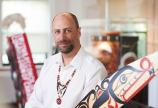

In this story
Keywords: Indigenous, libraries, archives, truth and reconciliation
People: Ry Moran
Publication: The Ring


